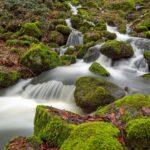Why Water Cycle Improvement in Oregon: Southeastern Oregon is also impacted by the water cycle shortages.?
Water Cycle Improvement near Oregon: Southeastern Oregon is also impacted by the water cycle shortages
The Water Cycle: A Vital Cycle Facing Challenges in the Great Basin
The Continuous Cycle of Water:
The Earth’s water is constantly moving in a continuous cycle driven by the sun’s energy. This cycle, known as the hydrologic cycle, involves the following key processes:
- Evaporation: The sun heats water in lakes, rivers, oceans, and soil, transforming it into water vapor (a gas) and releasing it into the atmosphere.
- Condensation: As the water vapor rises, it cools and condenses, forming tiny water droplets that create clouds.
- Precipitation: When the water droplets in clouds become too heavy, they fall back to Earth as rain, snow, sleet, or hail.
- Infiltration: Some precipitation soaks into the ground, replenishing groundwater sources.
- Runoff: The remaining precipitation flows over the land surface, eventually reaching rivers, lakes, and oceans.
The Water Cycle in the Great Basin:
The Great Basin, a vast desert region encompassing parts of seven western US states, relies heavily on the water cycle. However, the region is facing significant challenges due to:
- Climate Change: Rising temperatures and altered precipitation patterns caused by climate change are exacerbating existing water scarcity in the Great Basin. Warmer temperatures increase evaporation rates, leading to drier conditions and reduced snowpack, which is a crucial source of water for the region.
The Impact of Water Scarcity in the Great Basin:
Water scarcity has profound impacts on the region, affecting its environment, economy, and communities:
- Reduced Water Resources: The Great Basin is experiencing a decline in its water resources due to factors such as drought, increased evaporation, and unsustainable water usage.
- Agricultural Impacts: Farmers, who rely heavily on irrigation, face challenges due to limited water availability. This can lead to reduced crop yields, affecting food security for the region and beyond.
- Environmental Effects: Water scarcity puts pressure on natural ecosystems, impacting plant and animal life and contributing to habitat loss.
- Community Challenges: Limited water resources can strain communities, leading to conflicts over water allocation and economic challenges.
Solutions for a Thirsty Region:
The good news is, there are actions we can take to address the water scarcity challenge in the Great Basin and restore its water balance. These solutions include:
- Water Conservation: Implementing water-saving practices such as using efficient irrigation systems, fixing leaks, and reducing outdoor watering can significantly reduce water demand.
- Sustainable Water Management: Adopting water-efficient technologies and managing water resources responsibly can ensure that water is used sustainably and effectively.
- Climate Change Mitigation: Addressing climate change by reducing greenhouse gas emissions will help mitigate the impacts of rising temperatures and altered precipitation patterns on the Great Basin’s water resources.
- Community Engagement: Building partnerships between communities, government agencies, and organizations to develop comprehensive water management plans and implement sustainable solutions.
By understanding the water cycle, acknowledging the challenges facing the Great Basin, and implementing sustainable solutions, we can help ensure a healthy and thriving future for this vital region.
The Great Basin: A Thirsty Land
TL;DR – The Great Basin is a dry region facing a growing water shortage problem. Climate change is making the problem worse, but there are solutions like water conservation, new irrigation methods, and smart policies to help us keep the water flowing.
The Water Cycle in the Great Basin
The Great Basin is a big, high desert in the western United States, including parts of Nevada, Utah, California, Oregon, Idaho, and Wyoming. Like everywhere, the Great Basin has a water cycle. It’s a continuous process of water moving from the ground to the sky and back again:
- Evaporation: The sun heats up water in lakes, rivers, and the soil, turning it into water vapor (like steam) which rises into the air.
- Condensation: As the water vapor goes higher, it cools down and turns back into tiny water droplets, forming clouds.
- Precipitation: When the water droplets in the clouds get heavy enough, they fall back to the earth as rain, snow, or hail.
- Collection: The precipitation collects in rivers, lakes, and underground, feeding the cycle again.
Challenges of Water Shortages
The Great Basin is naturally dry, with less rainfall than many other parts of the United States. But in recent years, the problem has gotten worse. Here’s why:
- Climate Change: Climate change is causing the Great Basin to get hotter and drier, making it harder for snow to fall and for water to stay in the ground.
- Increased Demand: More people are moving to the Great Basin, putting more pressure on the limited water supply.
- Drought: Droughts happen when there is less rainfall than usual, making water shortages even more severe.
The Impact of Water Scarcity
When water is scarce, it affects everyone:
- Farmers: Farmers need water to grow crops, and less water means less food for everyone.
- Wildlife: Animals need water to drink and survive, and a lack of water can put endangered species at risk.
- Communities: People need water to drink, cook, and keep clean. Water shortages can lead to health problems and make it hard for communities to thrive.
Solutions for a Thirsty Region
The good news is, there are things we can do to help the Great Basin get its water back on track:
H3: Water Conservation
- Smart Watering: Using water-saving sprinklers and watering lawns only when they really need it can save a lot of water.
- Fixing Leaks: Leaky faucets and pipes waste a lot of water. Fixing them can make a big difference.
- Water-Wise Landscaping: Using drought-tolerant plants that need less water is a smart way to keep things green without using too much water.
H3: Innovative Irrigation
- Drip Irrigation: This method delivers water directly to plant roots, reducing evaporation and waste.
- Precision Irrigation: Using sensors to measure soil moisture helps farmers water only when and where it’s needed.
H3: Policy Measures
- Water Rights: Making sure water is allocated fairly and sustainably is key to managing the water supply.
- Incentives for Conservation: Governments and communities can offer financial help and other incentives to encourage people to save water.
The Active Climate Rescue Initiative
The Active Climate Rescue Initiative is working to solve the Great Basin’s water supply shortages. They are researching and implementing innovative solutions, like cloud seeding technology, to increase precipitation and replenish groundwater. They also work with communities to promote water conservation and sustainable practices.
H3: Importance of Collaboration
Solving the water shortage crisis in the Great Basin requires everyone to work together. Farmers, city governments, water managers, and individuals all have a role to play in using water wisely and protecting this precious resource. The Active Climate Rescue Initiative is a vital partner in this collaborative effort, driving innovation and advocating for sustainable water management. By working together, we can ensure a healthy and thriving future for the Great Basin.
More on Water Cycle Improvement…
- ## SEO Keywords for Water Cycle Improvement & Climate Change Impacts:
- General:
- Water cycle
- Climate change
- Water scarcity
- Climate change impacts
- Climate change mitigation
- Climate change adaptation
- Sustainability
- Environmental protection
- Water management
- Water conservation
- Water security
- Drought
- Floods
- Extreme weather
- Global warming
- Greenhouse gases
- Water Cycle Improvement:
- Water cycle management
- Water cycle restoration
- Water cycle efficiency
- Water cycle sustainability
- Rainwater harvesting
- Groundwater recharge
- Water filtration
- Water reuse
- Greywater recycling
- Water-efficient appliances
- Water-efficient landscaping
- Water conservation strategies
- Water cycle education
- Water cycle research
- Climate Change Impacts:
- Climate change and water resources
- Climate change and water scarcity
- Climate change and floods
- Climate change and droughts
- Climate change and agriculture
- Climate change and health
- Climate change and ecosystems
- Climate change and sea level rise
- Climate change and extreme weather
- Climate change and economic impact
- Climate change and human migration
- Climate change and biodiversity loss
- Climate change and food security
- Climate change and energy security
- Climate change and infrastructure
- Climate change and disaster management
- Specific Keywords:
- Groundwater depletion
- Water pollution
- Desalination
- Irrigation efficiency
- Sustainable agriculture
- Climate change resilience
- Climate action
- Climate finance
- Carbon footprint
- Renewable energy
- Green infrastructure
- Urban planning
- Climate change policies
- Climate change regulations
- Climate change law
- Long-Tail Keywords:
- How climate change impacts water resources
- Best practices for water cycle improvement
- Climate change adaptation strategies for water management
- The role of technology in water conservation
- The impact of climate change on agriculture and food security
- Climate change and the future of water resources
- Water cycle restoration projects
- The economic consequences of climate change
- Climate change mitigation and adaptation
- Sustainable water management in a changing climate
- Climate change and the global water crisis
- Water cycle education for children
- Water cycle research and development




